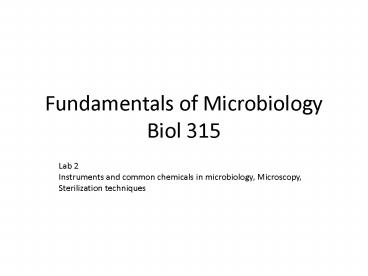Fundamentals of Microbiology Biol 315 - PowerPoint PPT Presentation
Title:
Fundamentals of Microbiology Biol 315
Description:
... (0-300 C) Incubator (0-120 C) pH Meter Hotplate and Magnetic Stirrer Laminar Flow Cabinet / Biosafety Cabinet ... The cabinet is kept under ... – PowerPoint PPT presentation
Number of Views:209
Avg rating:3.0/5.0
Title: Fundamentals of Microbiology Biol 315
1
Fundamentals of MicrobiologyBiol 315
Lab 2 Instruments and common chemicals in
microbiology, Microscopy, Sterilization techniques
2
Common Instruments
- Autoclave (121?C, 15 psi)
- Oven (0-300 ?C)
- Incubator (0-120 ?C)
- pH Meter
- Hotplate and Magnetic Stirrer
- Laminar Flow Cabinet / Biosafety Cabinet
3
AUTOCLAVE
4
http//textbookofbacteriology.net/autoclave1.jpg
5
http//i01.i.aliimg.com/photo/v0/108072579/Autocla
ve_Portable_Autoclave_Laboratory_Autoclave_Laborat
ory_Equipments.jpg
6
http//www.naanolabindia.com/laboratory-instrument
s/vertical-autoclave.jpg
7
http//www.pharmaceutical-int.com/upload/image_fil
es/articles/images/companies/865/large-capacity-au
toclave-b.jpg
8
http//www.theprominex.com/gallery/images/medical/
autoclave.jpg
9
Oven
10
http//2.imimg.com/data2/FU/BT/MY-2143786/1-250x25
0.jpg
11
http//images.hellotrade.com/data/T/W/MY-633236/Ho
t-Air-Oven---Lab-Model_250x250.jpg
12
http//faculty.ksu.edu.sa/baddour/PublishingImages
/hotairoven.jpg
13
INCUBATORS
14
http//www.stuart-equipment.com/adminimages/Incuba
tors_SI505_open.jpg
15
http//www.stuart-equipment.com/adminimages/Incuba
tors_SI505_closed.jpg
16
Shaking Incubator
http//www.ika.com/ika/product_art/images/3510000_
1.jpg
17
pH Meter
18
http//growsetup.files.wordpress.com/2011/02/3505-
ph-meter.jpg
19
Hotplate and magnetic stirrer
20
http//www.labdepotinc.com/admin/uploads/scilogex-
ms-h-s-m-10008-vlarge-r_1.jpg
21
http//www.troemner.com/images/hotplate_stirrers/a
dv_hps_lge.jpg
22
http//pimg.tradeindia.com/00076902/b/0/Laboratori
es-Magnetic-Stirrer-Hotplate.jpg
23
Biosafety cabinet
24
http//www.terrauniversal.com/gallery/hoods/Images
/biological_safety_cabinet_purifier_Cover.jpg
25
Class I Cabinets
- These cabinets have unrecirculated airflow away
from the operator that is discharged to the
atmosphere after filtration through a HEPA
filter. - They provide good operator protection but do not
protect the material within the cabinet (the
product) from contamination.
26
(No Transcript)
27
Class II Cabinets
- Class II cabinets are designed for personnel,
product and environmental protection. - They are designed for work involving
microorganisms in containment levels 2, 3 and 4
laboratories. - Class II cabinets are most commonly used in
biomedical research laboratories because of their
characteristics.
28
(No Transcript)
29
http//escoglobal.com/products/images/products-big
/1322810342.jpg
30
Class III Cabinets
- Class III cabinets are totally enclosed and
gas-tight with HEPA filtered supply and exhaust
air. Work is performed with attached long-sleeved
gloves. - The cabinet is kept under negative pressure and
airflow is maintained by a dedicated exterior
exhaust system. - Class III cabinets protect the worker and the
product. They are designed for work with level 4
pathogens. - The exhaust air is double HEPA filtered or
treated by HEPA filter and incineration.
31
http//www.phac-aspc.gc.ca/publicat/lbg-ldmbl-04/g
fx/fig6_e.gif
32
http//doh.sd.gov/img/bsc.jpg
33
http//www.nap.edu/books/0309075718/xhtml/images/p
20005395g49001.jpg
34
http//escoglobal.com/products/images/products-big
/AC2-D.jpg
35
http//web.princeton.edu/sites/ehs/biosafety/biosa
fetypage/BSC2.jpg
36
Chemicals
- Media (solid and liquid)
- Nutrient agar, nutrient broth
- EMB agar, MacConkeys agar, Blood agar
- Lactose broth
- Grams staining kit
- Catalase reagent
- Oxidase reagent
37
Microscopy
- Light microscope
- Photography and video making through microscope
using live camera - Other kinds of microscopy
38
Grams Staining result
39
http//janiceatmeredith.files.wordpress.com/2012/0
1/gramsta.gif
40
THANK YOU

